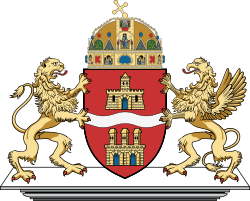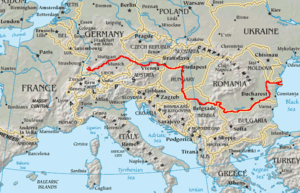Hungarian Parliament Building
The Hungarian Parliament Building (Hungarian: Országház, pronounced [ˈorsaːghaːz], which translates to House of the Country or House of the Nation), also known as the Parliament of Budapest after its location,[5] is the seat of the National Assembly of Hungary, a notable landmark of Hungary, and a popular tourist destination in Budapest. It is situated on Kossuth Square in the Pest side of the city, on the eastern bank of the Danube. It was designed by Hungarian architect Imre Steindl in neo-Gothic style and opened in 1902.[6] It has been the largest building in Hungary since its completion.[7]
| Hungarian Parliament Building | |
|---|---|
Országház | |
 The main façade as seen from across the Danube | |

| |
| General information | |
| Type | Parliament |
| Architectural style | Gothic Revival, baroque, renaissance |
| Location | Budapest, Hungary |
| Coordinates | 47.506944°N 19.045556°E |
| Current tenants | National Assembly of Hungary |
| Groundbreaking | 1885 |
| Completed | 1904 |
| Height | 96 m (315 ft) |
| Dimensions | |
| Other dimensions | Width: 123 m (404 ft) Length: 268 m (879 ft) |
| Technical details | |
| Floor count | 4 |
| Floor area | 18,000 m2 (193,800 sq ft) |
| Lifts/elevators | 13 |
| Design and construction | |
| Architect | Imre Steindl |
| Other information | |
| Number of rooms | 691 |
| Website | |
| www.latogatokozpont.parlament.hu | |
| References | |
| [1][2][3][4] | |
| UNESCO World Heritage Site | |
|---|---|
| Official name | Budapest, including the Banks of the Danube, the Buda Castle Quarter and Andrássy Avenue |
| Criteria | Cultural: ii, iv |
| Reference | 400 |
| Inscription | 2002 (26th session) |
| Area | 473.3 ha |
| Buffer zone | 493.8 ha |
History

Budapest was united from three cities in 1873, namely Buda, Óbuda, and Pest.[8] Seven years later the Diet resolved to establish a new, representative parliament building, expressing the sovereignty of the nation. The building was planned to face the Danube River. An international competition was held, and Imre Steindl emerged as the victor;[6] the plans of two other competitors were later also realized in the form of the Ethnographic Museum and the Hungarian Ministry of Agriculture, both facing the Parliament Building. Construction from the winning plan was started in 1885, and the building was inaugurated on the presumed 1,000th anniversary of the country in 1896. It was not fully completed until 1904. The architect of the building first went blind and then later, died before its completion.
About 100,000 people were involved in construction, during which 40 million bricks, half a million precious stones and 40 kilograms (88 lb) of gold were used. Since World War II the legislature became unicameral, and today the government uses only a small portion of the building. During the People's Republic of Hungary a red star perched on the top of the dome, but it was removed in 1990 after the fall of communism. Mátyás Szűrös declared the Hungarian Republic from the balcony facing Kossuth Lajos Square on 23 October 1989.
Features

The Parliament Building is built in the Gothic Revival style; it has a symmetrical façade and a central dome. The dome is Renaissance Revival architecture.[9] The parliament is also largely symmetrical from the inside, with two identical parliament halls on the opposing sides of the building. One of the two halls is still in use today for sessions of the Hungarian National Assembly, the other for ceremonies, conferences, and guided tours. It is 268 m (879 ft) long and 123 m (404 ft) wide. Its interior includes 10 courtyards, 13 passengers and freight elevators, 27 gates, 29 staircases and 691 rooms (which includes more than 200 offices). With its height of 96 m (315 ft), it is one of the two tallest buildings in Budapest, along with Saint Stephen's Basilica. The number 96 refers to the nation's millennium, 1896, and the conquest of the later Kingdom of Hungary in 896. It is free to enter before 8 am.
The main façade overlooks the River Danube, but the official main entrance is from the square on the east side of the building. Inside and outside, there are altogether 242 sculptures on the walls. The façade displays statues of Hungarian rulers, Transylvanian leaders and famous military figures. The coats of arms of kings and dukes are depicted over the windows. The eastern staircase is flanked by two lions. When entering the Parliament, visitors can walk up great ornamental stairs, see frescoes on the ceiling, and pass by the bust of the architect, Imre Steindl, in a wall niche. Other statues include those of Árpád, Stephen I and John Hunyadi. The building features stained glass and glass mosaics by Miksa Róth.
One of the famous parts of the building is the hexadecagonal (sixteen-sided) central hall, with huge chambers adjoining it: the Lower House and the Upper House. The modern National Assembly is unicameral and meets in the Lower House, while the Upper House is used as a conference and meeting room. The Holy Crown of Hungary, which is also depicted in the coat of arms of Hungary, has been displayed in the central hall since 2000. Due to its extensive surface and its detailed handiwork, the building is almost always under renovation.
Accessibility and neighbourhood
The Parliament is accessible with Line 2 of the Budapest Metro and with tram line 2, from the Kossuth Lajos Square station. At the east front of the building is a memorial to the 1956 Hungarian Revolution, as well as the imposing Kossuth Memorial and the equestrian statue of Francis II Rákóczi. A seated statue of Attila József as described in his poem By the Danube occupies a site on the south lawn. Martyrs' Square (Vértanúk tere) is immediately adjacent to Kossuth Square, with a statue of Imre Nagy.
Postage stamps
The building features on more than 50 postage stamps issued by Hungary during 1917–1921. Some of them are: In 1917,[10] 1919,[11] 15 April 1920,[12] and 1921.[13]
Gallery
Interior
 Interior of one of the rooms in the building
Interior of one of the rooms in the building.jpg) Assembly hall of the National Assembly of Hungary
Assembly hall of the National Assembly of Hungary The main staircase of the parliament building
The main staircase of the parliament building.jpg) Another view of the main staircase
Another view of the main staircase The Holy Crown of Hungary can be found in the central hall
The Holy Crown of Hungary can be found in the central hall Model found inside the building
Model found inside the building
Exterior
_2015-02.jpg) View of the main façade in the evening
View of the main façade in the evening View of the rear façade
View of the rear façade Rear façade at night
Rear façade at night- Rear entrance doors
 Aerial of the rear façade
Aerial of the rear façade Aerial of the main façade
Aerial of the main façade- Statue of Gyula Andrássy near the south side of the building
Stamps
 A 1918 stamp with the parliament building
A 1918 stamp with the parliament building A 1918 stamp with the parliament building
A 1918 stamp with the parliament building
References
- Béni, Alexandra (13 June 2017). "10+1 things you didn't know about the Hungarian Parliament". Daily News Hungary. Daily News Hungary. Retrieved 29 June 2019.
- "Parliament". Budapest Info. Budapest Info. n.d. Retrieved 29 June 2019.
- Kay, Nathan (3 January 2019). "The secrets and symbols of Hungary's Parliament building". CNN Travel. CNN. Retrieved 29 June 2019.
- "The House of Parliament". House of Parliament Visitor Center. Hungarian National Assembly. n.d. Retrieved 29 June 2019.
- "The Hungarian Parliament Building". Parlamento Budapest. 2016. Retrieved 8 April 2016.
- Craig Turp (2010). DK Eyewitness Top 10 Travel Guide: Budapest. Dorling Kindersley Ltd. pp. 8–9.
- "Parliament". Budapest Info. 4 March 2015. Archived from the original on 13 September 2015. Retrieved 8 April 2016.
- "Buda, Obuda, and Pest" (XML). Brill.com. Retrieved 22 April 2019.
- Steves, Rick; Hewitt, Cameron (2009). Rick Steves' Budapest. Avalon Travel Publishing. ISBN 978-1-59880-217-7.
- "Stamp: Parliament building (Hungary) (Parliament building) Mi:HU 200,Sn:HU 119,Yt:HU 175,AFA:HU 175". Colnect.com. Retrieved 22 April 2019.
- "Stamp: Parliament building (Hungary) (Parliament building) Mi:HU 253b,Sn:HU 189,Yt:HU 231,AFA:HU 231B". Colnect.com. Retrieved 22 April 2019.
- "Stamp: Parliament building (Hungary) (Parliament building) Mi:HU 317,Sn:HU 188,Yt:HU 230,AFA:HU 230". Colnect.com. Retrieved 22 April 2019.
- "Stamp: Parliament Building, triangular punching (Hungary) (Parliament building) Mi:HU 203L". Colnect.com. Retrieved 22 April 2019.
External links
| Wikimedia Commons has media related to Hungarian Parliament Building. |


